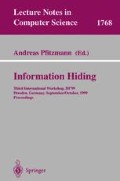Abstract
Rivest developed the concept of chaffing, a technique based on blending authenticated plaintext information with non authenticated noise (chaff) to obscure the true message as a method of subverting controls on strong cryptography in an arena in which strong authentication is unregulated. Assuming a secret authentication key shared between the sender and the receiver, only the intended recipient can easily separate the message content from the noise (winnowing).
We look at ways in which the winnowing and chaffing processes might be made more efficient. We begin by considering the winnowing process as error correction (another unregulated technology) and consider the effectiveness of shorter authentication codes. In the limit, we show that we can transmit only a single bit of authentication material in place of a single bit of data, but in this limit, our process is equivalent to XORing the message with a similar sized random bit stream.
Access this chapter
Tax calculation will be finalised at checkout
Purchases are for personal use only
Preview
Unable to display preview. Download preview PDF.
References
Krawczyk, H., Bellare, M., Canetti, R.: Hmac: Keyed-hashing for message authentication. RFC 2104 (February 1997), Available at ftp://ds.internic.net/rfc/rfc2104.txt
Pfitzmann, A.: Lecture notes for Datensicherheit und Kryptographie, TU Dresden (March 1998), http://ikt.inf.tu-dresden.de/~pfitza/DSuKrypt.html
Rivest, R.L.: Chaffing and winnowing: Confidentiality without encryption., Available from http://theory.lcs.mit.edu/~rivest/chaffing-980701.txt
Rivest, R.L.: The md5 message-digest algorithm. RFC 1321 (April 1992), Available at ftp://ds.internic.net/rfc/rfc1321.txt
Rivest, R.L.: All-or-nothing encryption and the package transform. In: Proceedings of the 1997 Fast Software Encryption Conference, Springer, Heidelberg (1997), http://theory.lcs.mit.edu/~rivest/fusion.ps
Schneier, B.: Applied Cryptography, 2nd edn. John Wiley & Sons, Chichester (1996)
Author information
Authors and Affiliations
Editor information
Editors and Affiliations
Rights and permissions
Copyright information
© 2000 Springer-Verlag Berlin Heidelberg
About this paper
Cite this paper
McHugh, J. (2000). Chaffing at the Bit. In: Pfitzmann, A. (eds) Information Hiding. IH 1999. Lecture Notes in Computer Science, vol 1768. Springer, Berlin, Heidelberg. https://doi.org/10.1007/10719724_27
Download citation
DOI: https://doi.org/10.1007/10719724_27
Publisher Name: Springer, Berlin, Heidelberg
Print ISBN: 978-3-540-67182-4
Online ISBN: 978-3-540-46514-0
eBook Packages: Springer Book Archive

